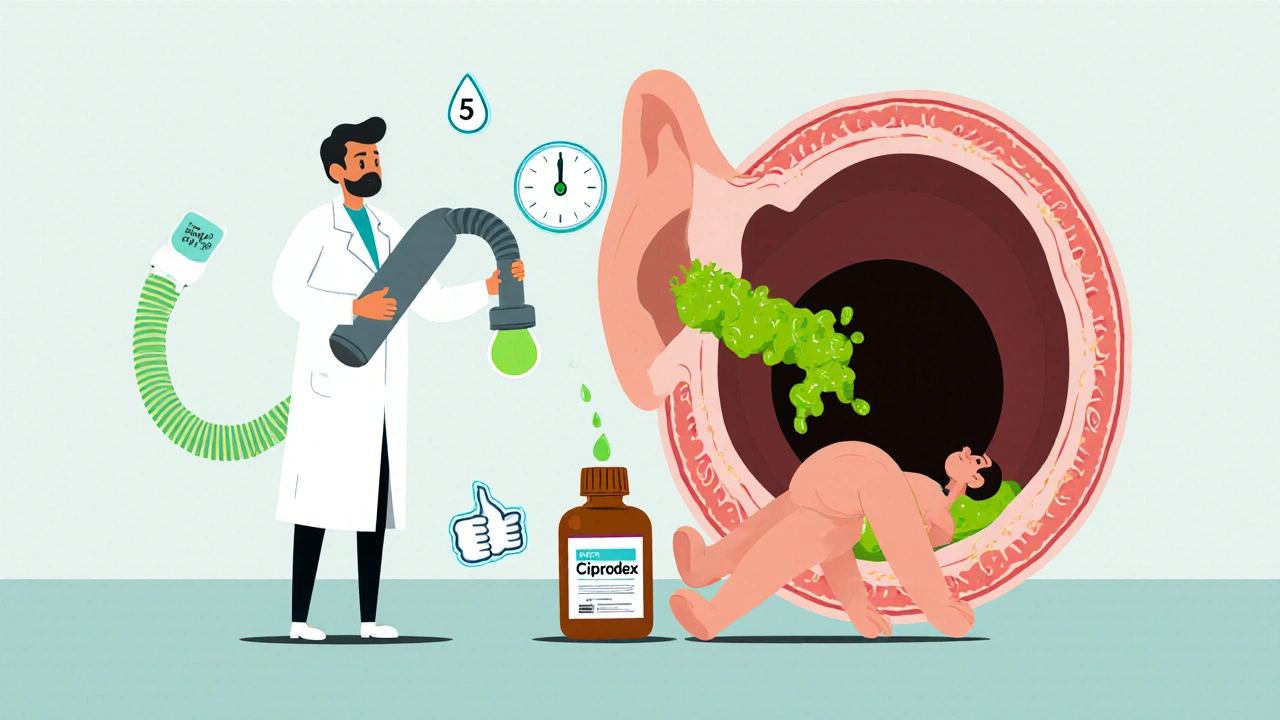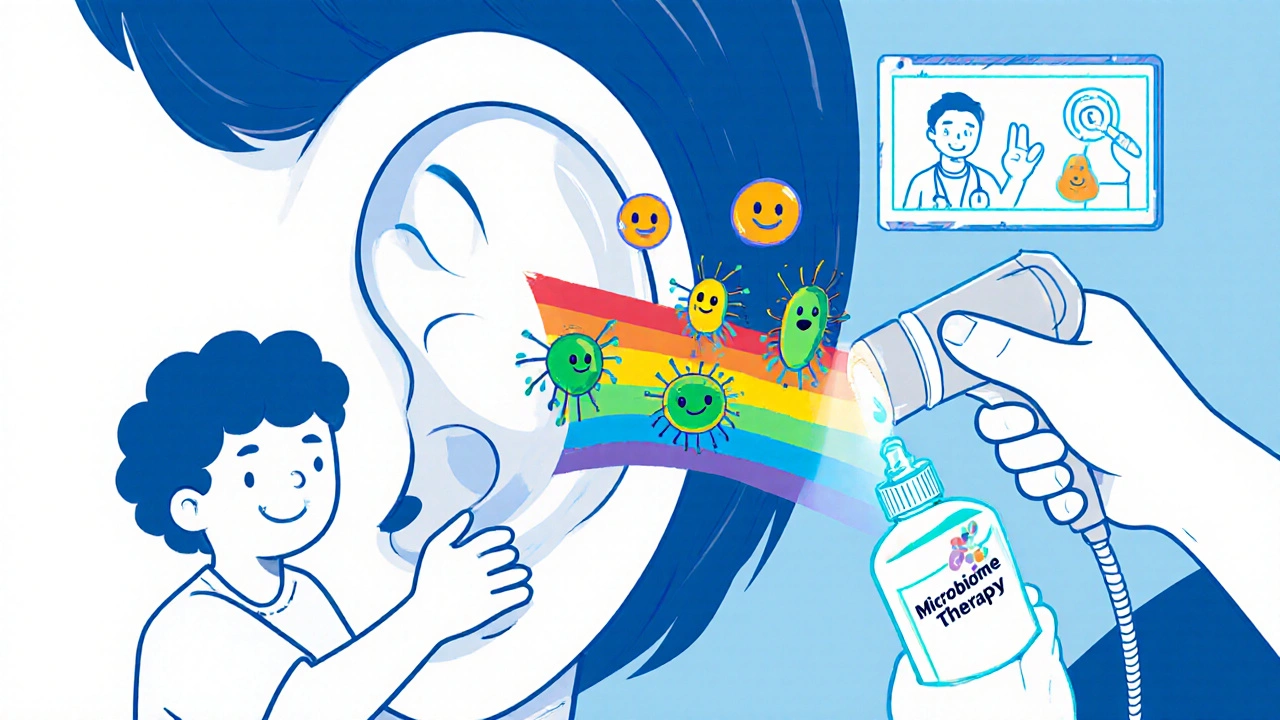Swimmer’s ear isn’t just a nuisance after a long day at the pool-it’s a real infection that can turn a simple splash into days of pain, muffled hearing, and discomfort. Unlike middle ear infections, which happen behind the eardrum, otitis externa attacks the skin of the outer ear canal-the tube that runs from your eardrum to the outside of your head. This isn’t just about water getting trapped. It’s about your ear’s natural defenses breaking down, letting bacteria or fungi take over.
Why Your Ear Gets Infected After Swimming
Water isn’t the enemy. It’s what happens when water stays in your ear that causes trouble. The ear canal is designed to be slightly acidic-between pH 5.0 and 5.7-to keep germs from growing. But repeated exposure to water, especially chlorinated or saltwater, washes away the protective layer of earwax. That’s when bacteria like Pseudomonas aeruginosa (responsible for over half of cases) and Staphylococcus aureus move in.
It’s not just swimmers. People who shower often, use hearing aids, or clean their ears with cotton swabs are also at risk. Swabbing doesn’t clean the canal-it pushes wax deeper and scrapes the delicate skin, creating tiny wounds where infection can start. Even scratching your ear with a fingernail can open the door.
When the canal swells, it gets narrow. That’s when pain gets worse. You might feel pressure, hear your own voice echoing, or notice pus or fluid draining. In severe cases, the swelling can block the ear completely, and you might even get a fever.
What Works: The Science Behind Effective Ear Drops
Not all ear drops are created equal. The right treatment depends on whether it’s bacterial or fungal, and how bad it is.
Mild cases (itching, slight redness, no blockage) often respond well to 2% acetic acid with hydrocortisone-sold as VoSoL HC Otic or generic versions. This combo restores the ear’s natural acidity and reduces swelling. Studies show it works in 85% of mild cases. It’s cheap-around $15-and available over the counter. Many swimmers use it after swimming as a preventive. One user on Reddit said, “I’ve used it every time after diving for years. Never had an infection.”
Moderate to severe cases (pain, swelling, muffled hearing) need something stronger. That’s where ciprofloxacin with dexamethasone (Ciprodex) comes in. This prescription drop kills bacteria and shuts down inflammation in one bottle. Clinical trials show 92% of people feel better within 7 days. It’s the gold standard. But it costs about $147.50 without insurance.
There are cheaper alternatives. Generic ofloxacin drops (like OtiRx) work almost as well-90% cure rate-and cost around $45. They’re a good option if you can’t afford Ciprodex. But avoid older drops like neomycin-polymyxin. They’re less effective, and if you have a perforated eardrum, they can damage your hearing.
If you think it’s fungal (often called otomycosis)-think white or black debris in the ear, intense itching, and no improvement with antibiotic drops-then you need clotrimazole 1%. A 2021 JAMA study found it cleared fungal infections in 93% of cases. Acetic acid won’t touch it.
Why You’re Not Getting Better (And What You’re Doing Wrong)
Many people use ear drops and still don’t improve. Why? It’s usually not the medicine-it’s how they’re used.
First: debridement. That’s a fancy word for cleaning out the ear canal. If there’s wax, pus, or dead skin blocking the drops, the medicine can’t reach the infection. A doctor uses suction or a tiny tool to clear it out. Studies show this makes drops 30-40% more effective. Don’t try this yourself. Cotton swabs make it worse.
Second: position matters. Lying on your side with the infected ear facing up, putting in the drops, and staying still for 5 minutes isn’t optional. If you sit up right away, half the drops just leak out. A 2022 Cleveland Clinic survey found 32% of people skipped this step-and their treatment failed 40% more often.
Third: don’t guess the cause. If you have diabetes or a weakened immune system, even a mild ear infection can turn dangerous. If you’ve tried over-the-counter drops for 3 days and it’s not better, see a doctor. One in five people who self-treat with the wrong drops end up in the ER with a worse infection.

When to Skip the Drops Altogether
Some cases need more than drops.
If the ear canal is completely blocked by swelling, a doctor may insert an ear wick-a small sponge that expands inside the canal. It holds the drops in place and helps the swelling go down. It’s uncomfortable, but necessary. About 65% of patients say it’s worth it.
Systemic antibiotics (pills) are rarely needed. The American Academy of Otolaryngology says they add almost nothing to topical treatment and increase side effects like stomach upset or yeast infections. Save them for rare cases where the infection spreads beyond the ear canal.
What’s New in 2025
There’s no miracle cure yet, but things are improving. In March 2023, the FDA approved OtiRx, a new version of ofloxacin that lasts 24 hours instead of 12. That means fewer doses-once a day instead of twice. Early results show 94% success.
Telemedicine is helping too. Mayo Clinic’s video consultations for ear infections now match in-person diagnosis accuracy 88% of the time. You can show your ear on camera, describe symptoms, and get a prescription without leaving home.
Future treatments are even more exciting. Stanford University is testing a microbiome-based therapy that reintroduces healthy bacteria to the ear canal to outcompete the bad ones. It’s still in trials, but it could one day replace antibiotics entirely.

Prevention: Stop It Before It Starts
The best treatment is no treatment. Here’s what actually works:
- After swimming or showering, tilt your head and gently pull your earlobe to help water drain.
- Use a hairdryer on low, cool setting, held at least a foot away, to dry the ear.
- Use 2% acetic acid drops (like Swim-Ear) after water exposure. It cuts recurrence by 65%.
- Never stick anything smaller than your elbow in your ear.
- If you’re diabetic or have a history of ear infections, talk to your doctor about preventive drops before swimming season.
Swimmer’s ear isn’t a sign of poor hygiene. It’s a common, treatable condition. But it rewards smart prevention and proper treatment-not guesswork.
Can I use hydrogen peroxide to clean my ear if I have swimmer’s ear?
No. Hydrogen peroxide can irritate the already inflamed skin of the ear canal and delay healing. It’s not a treatment for infection. If you need to clean your ear, gently wipe the outer part with a damp cloth. Never pour anything into the canal unless it’s a doctor-recommended drop.
Are ear drops safe for children?
Yes, most prescription and OTC ear drops are safe for children over 2 years old, but always check the label or ask a doctor. Ciprodex and acetic acid drops are commonly prescribed for kids. Avoid neomycin-based drops in children because of the rare risk of hearing damage if the eardrum is perforated.
How long does it take for swimmer’s ear drops to work?
Pain usually starts to improve within 24 to 48 hours with the right drops. Full healing takes 7 to 10 days. If you don’t feel better after 3 days, or if your symptoms get worse, see a doctor. You might have the wrong diagnosis or need a different treatment.
Can I swim while I have swimmer’s ear?
Avoid swimming until the infection clears. Water can delay healing and spread the infection. If you must swim, use waterproof earplugs and dry your ears thoroughly afterward. Some people use preventive drops before and after swimming to reduce risk.
Why does my ear hurt more at night?
Lying down increases pressure in the ear canal, which makes swelling and pain feel worse. Also, at night, there are fewer distractions, so you notice the pain more. Using a pillow that keeps your head elevated can help reduce pressure.
Is swimmer’s ear contagious?
No, swimmer’s ear isn’t contagious. You can’t catch it from someone else. But sharing earbuds, headphones, or swim gear can transfer moisture and bacteria, which might increase your risk if you’re already prone to infections.
What to Do If Nothing’s Working
If you’ve tried the right drops, followed instructions, and still have pain after 10 days, it’s time to see an ENT specialist. You might have:
- A fungal infection that was misdiagnosed as bacterial
- A perforated eardrum you didn’t know about
- A rare form called malignant otitis externa (very rare, but dangerous in diabetics or older adults)
Don’t keep trying different OTC products. That delays real treatment. A doctor can take a sample of any discharge, test it, and give you the exact medicine you need.
Otitis externa is common. It’s treatable. But it demands respect-not just a quick fix. Use the right drops, apply them correctly, and prevent it before it starts. Your ears will thank you.
 Nov, 27 2025
Nov, 27 2025
